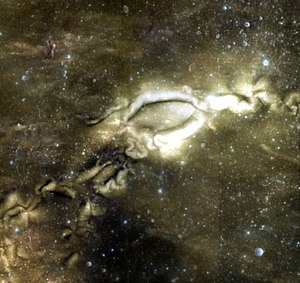Pure gamma
| Territory on the moon | ||
|---|---|---|
| Pure gamma | ||

|
||
| Pure gamma. Uptake by the Clementine probe . | ||
|
|
||
| position | 7 ° 30 ′ N , 59 ° 0 ′ W | |
| history | ||
| Named after | Moon crater Reiner , named after Vincentio Reinieri | |
Pure gamma is a so-called swirl , an area of unusual brightness in the Oceanus Procellarum on the moon . It is selenografisch at 7 ° 30 'North 59 ° 00' West, near the crater Reiner , after and its namesake Vincentio Reinieri († 1648) is from the 1935 International Astronomical Union has been designated (IAU). The mean diameter of the swirling oval structure is about 70 kilometers. The most striking feature is the albedo , which differs from its environment, a mare .
Theories
Early astronomers incorrectly assumed that the structure was a crater. Giovanni Riccioli named this Galilaeus after Galileo Galilei . It was later found to be not a crater, and the name Galilei was carried over to another crater .
With the realization that the structure was not a depression or elevation in the terrain and was not based on any previous lava eruption, it became a mystery. But after similar irregularities were discovered in Mare Ingenii and Mare Marginis , it was possible to develop a theory based on these new findings. The anomalies are almost exactly opposite the centers of other Maria's basins, and it is therefore believed that they formed at the same time as these impact craters from the seismic faults and reflected energies of the impacts . However, the fact that there is no suitable crater opposite Reiner Gamma and that the other brightness anomalies are not exactly centered to the assigned Maria on the opposite side of the moon is problematic.
In 1972, sub- satellites launched by Apollo 15 and 16 in orbit around the moon discovered that Reiner Gamma possesses a magnetic field . This is similar in structure to a dipole . In addition, it was possible to measure relatively strong magnetic fields near the irregularities. The exact reason for this is unknown, but it is believed to be related to the theory of causative impacts.
The magnetic field is strong enough to deflect the solar wind . Since it is believed that the solar wind darkens the lunar surface for millions of years, it is speculated that the albedo anomaly may be due to the magnetic anomaly.
Web links
- Reiner Gamma in the Gazetteer of Planetary Nomenclature of the IAU (WGPSN) / USGS
- NASA: Mysterious Lunar Swirls (English)
- The-moon.wikispaces.com: Reiner Gamma (English)
- scinexx.de: Did a "parasol" effect create the moon vortex? 1st March 2019
- Spektrum.de : Amateur recordings [1] [2]
